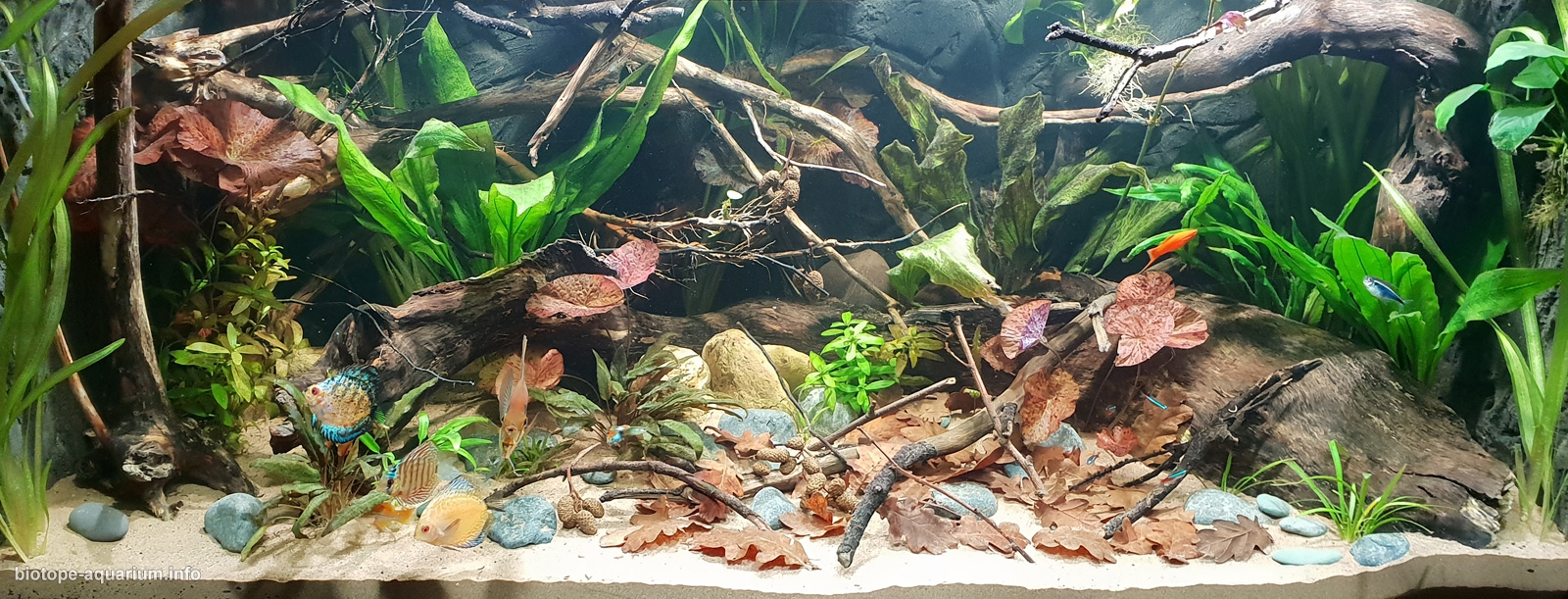
Volume: 486 L
Dimensions: 130x60x60 cm
List of fishes: Pterophyllum scalare, Symphysodon discus, Paracheirodon innesi, Hyphessobrycon herbertaxelrodi, Xiphophorus hellerii, Hyphessobrycon sweglesi, Corydoras aeneus, Ancistrus dolichopterus
List of plants: Vallisneria spiralis, Ludwigia repens, Nymphaea lotus, Cryptocoryne wendtii, Echinodorus “Ozelot”
Description of decorations: Quartz sand selected under Biotop with a slight shade of red, stones, roots selected and arranged in the most natural way, oak leaves to add a more realistic look to Biotope.
Description of equipment: Jbl e900 -900l/h , EHEIM 11245 – 1000l/h , heater – 200w , 100w , LED lighting 3x 30 w – 2400lm / 6500k.
Water parameters: Temperature is 27*C Ph-6,5 , Ca~35mg/l , Mg~10mg/l , NO3~5-10mg/l , PO4~0.6-1.2mg/l.
INFORMATION ABOUT BIOTOPE
Description of the area surrounding the biotope: Floodplains – these are naturally flat areas located along the main stream of the Amazon River and its tributaries in the Amazon Basin, which are flooded twice a year during the rainy season. These areas are covered by wet equatorial forests, also known as tropical forest or rainforest. The rainy season lasts about 200 days a year. Then the width of the river reaches about 48 km, its level increases by 15 meters, and floodplains can reach up to 70 km from its shore. So even 100,000 km2 of forests are flooded. These floods enrich the soil of forests with fertile mules and sediments, and the huge migration of animals – including fish. These conditions forced animals and plants to adapt to them. Hence the tangle of supporting roots in trees, adaptation of fish to cracking nuts (large mouths and powerful jaws, eg in piranhas), adaptation of fish to life in an environment poor in oxygen (intestinal breathing eg in crayfish), etc. The appearance of water from flooded areas varies depending on the type of ground and along with their distance from the main riverbed. The greater this distance, the floodplains are richer in vegetation, more transparent, filled with alternating layers of thick and small sediments, covered with a thick layer of forest litter. Due to the large amount of organic matter and a high degree of its distribution and decreasing water movement, the amount of oxygen decreases with the distance from the mainstream. The type of substrate affects, and the type of vegetation. Floodplains basically constitute the entire system of islands, side channels, dams and floodplain lakes to which fish are transferred along with a flood wave. These calmer, warmer waters, with greater electrical conductivity, ensuring the richness of food are used by animals for reproduction.
Description of the underwater landscape of the biotope: Clearwater – rivers that are no different from the rivers known to us – have a blue-green color, high transparency. They are characterized by a strong current, which, however, slightly rinsing out the sediments from the sparingly soluble substrate. These types of rivers are found mainly in the Brazilian Upland, including the following tributaries of the Amazon River: Rio Tapajos, Rio Xingu, Rio Aripuana and Rio Ji-Parana (tributaries of the Rio Madeira River). Floodplains within these rivers are characterized by low fertility (sandy soils) and locally are called igapos.
Description of the parameters of the habitat: The Amazon and its tributaries can be divided into five different types of watercourses, which differ in terms of water color, ecological properties and organisms that occur there. In addition to these types, there are a large number of rivers, streams and tributaries with mixed features that can not be clearly classified. The first scientific classification of Amazonian waters was developed in 1950 by Sioli, who used the following parameters to organize the hydrological features of these waters: the color of water, its transparency, pH and electrical conductivity. In this way, he specified white (whitewater), blackwater (blackwater) and clearwater (whitewater). These types are the determinant for aquarists from around the world in the creation of aquariums about the South American biotope.
List of fishes and invertebrates occurring in the nature biotope: purpurea: Poecilia reticulata (guppy), Phalloceros caudimaculatus (viviparous phlebitis); backbone: Sartor respectus, Abramites hypselonotus (marbled slash), Leporinus falcipinnis, Leporinus maculatus, Leporinus desmotes; tetras: Gasteropelecus sternicla (silver trout); Angiosperms: Hyphessobrycon cachimbensis, Moenkhausia heikoi, Astyanax guianensis, Hyphessobrycon heliacus, Hyphessobrycon loweae, Hyphessobrycon heterorhabdus (three-cornered thrust), Microschemobrycon elongatus, Inpaichthys kerri (neon blue); Auchenipteridae: Tatia intermedia; pirates: Ossubtus xinguense, Myleus schomburgkii (striped piranha), Myleus setiger, Metynnis maculatus, Acnodon normani; Erythrinidae: Hoplias curupira; spearmers: Corydoras apiaka, Corydoras bifasciatus, Corydoras gracilis (brown crabs), Corydoras ornatus, Corydoras xinguensi; redfish: Ancistrus ranunculus, Baryancistrus chrysolomus (L-047), Baryancistrus xanthellus (L-018 collector), Harttia dissidens, Hypostomus soniae (L-137 collector), Hypancistrus zebra (zebra zebra, L-046 collector), Leporacanthicus joselimai ( collector L-264), Oligancistrus punctatissimus, Parancistrus nudiventris (L-031, L-176, L-300), Peckoltia compta (L-134), Peckoltia feldbergae, Scobinancistrus aureatus (L-014 collector), Scobinancistrus pariolispos ( collector L-048), Spectracanthicus murinus, Spectracanthicus zuanoni (L-354 collector), Panaque armbrusteri (L-027 collector), Panaque nigrolineatus (black-striped fish, L-190 collector), Pterygoplichthys joselimaianus (L-001 ); fricidae: Tenellus ternetzi; cichlid: Aequidens epae, Aequidens michael, Apistogramma arua, Cichla kelberi, Cichla melaniae, Cichla pinima, Crenicichla percna, Chaetobranchopsis orbicularis, Geophagus altifrons, Geophagus argyrostictus, Symphysodon aequifasciatus (green discus), Teleocichla centisquama, Teleocichla prionogenys, Teleocichla proselytus, Dicrossus filamentosus (Cichlid perch), Krobia xinguensis, Heros severus, Uaru amphiacanthoides (royal uaru, uaru cichlid), Pterophyllum scalare (scalarfish), Mikrogeophagus altispinosus (Bolivian cichlid), Biotodoma cupido, Satanoperca jurupari; Potamotrygonidae: Potamotrygon leopoldi, Potamotrygon orbignyi; Hemiodontidae: Hemiodus gracilis (slender coryneform).
List of plants found in the nature biotope: Alternanthera aquatica (Alternatera aquatic), Bacopa australis, Bacopa lanigera (Helminth), Ceratopteris thalictroides, Cuphea anagalloidea (Rotala araguaia), Echinodorus decumbens, Echinodorus inpai, Echinodorus macrophyllus, Great Echinodorus (Great Frog), Echinodorus palaefolius, Echinodorus paniculatus, Eleocharis acicularis, Eleocharis sp. “Xingu”, Hedyotis salzmanii, Lilaeopsis macloviana, Ludwigia helminthorrhiza, Mayaca fluviatilis, Staurogyne stolonifera, Tonina fluviatilis (River Tonina); mosses: Ceratopteris richardii, Azolla cristata, Leptodictyum riparium.
Threats to the ecology: The greatest threat to the Amazon River is the Human.
Sources of information:
